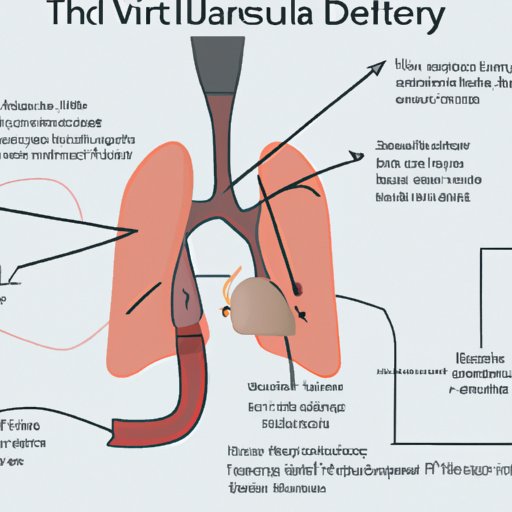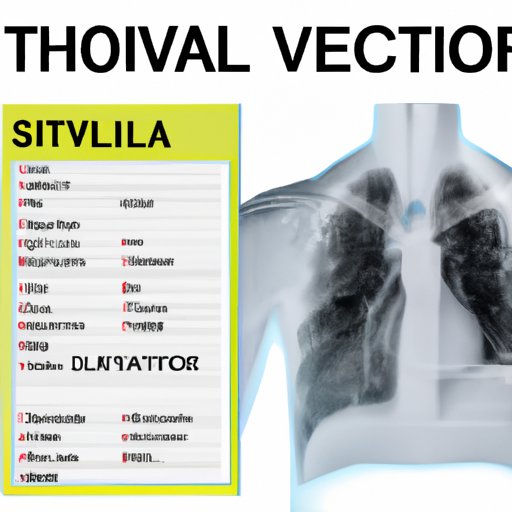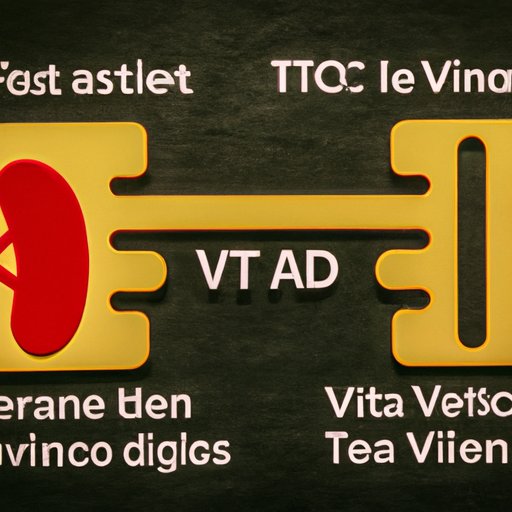Introduction
Deep vein thrombosis (DVT) is a medical condition that occurs when a blood clot forms in a deep vein, usually in the lower extremities. It can be a serious condition because if the clot dislodges and travels to the lungs, it can cause a pulmonary embolism, which is a blockage of an artery in the lungs. In some cases, this can be fatal. To prevent such a complication, it’s important to understand the anatomy of a DVT traveling to the lungs, the risk factors for developing a DVT-related pulmonary embolism, the symptoms of a DVT traveling to the lungs, the available treatment options, the prevention strategies to avoid DVT from reaching the lungs, and the long-term effects of a DVT in the lungs.

Describing the Anatomy of a DVT Journey to the Lung
A DVT typically begins as a blood clot in a vein in the lower extremities, such as the calf or thigh. From there, it can travel through the body’s circulatory system and end up in the lungs. The process by which a DVT travels to the lungs is known as thromboembolism. When a clot becomes lodged in an artery in the lungs, it can cause a pulmonary embolism.
The potential complications of a DVT traveling to the lungs are numerous. These include chest pain, shortness of breath, coughing up blood, rapid heart rate, and even death in some cases. Therefore, it’s important to recognize the signs of a DVT traveling to the lungs and seek medical attention immediately.
Examining the Risk Factors for Developing a DVT-related Pulmonary Embolism
There are several risk factors that can increase one’s chances of developing a DVT-related pulmonary embolism. These include age, obesity, smoking, prolonged bed rest, surgery, and certain medical conditions such as cancer and heart disease. People with any of these risk factors should be especially vigilant about monitoring their health and seeking medical attention if they experience any symptoms of a DVT.
In addition to being aware of risk factors, people can take steps to reduce their risk of developing a DVT. This includes exercising regularly, eating a healthy diet, maintaining a healthy weight, avoiding smoking, and wearing compression stockings during extended periods of bed rest or travel.

Assessing the Symptoms of a DVT Traveling to the Lung
The symptoms of a DVT traveling to the lungs vary depending on the severity of the clot and its location. Common symptoms include chest pain, difficulty breathing, coughing up blood, and rapid heart rate. Other signs, such as swelling and tenderness in the affected leg, can help indicate whether a DVT has traveled to the lungs.
It’s important to recognize the warning signs of a DVT-related pulmonary embolism. If any of the above symptoms are present, it’s vital to seek medical attention right away. Prompt diagnosis and treatment can help reduce the risk of further complications.

Exploring Treatment Options for a DVT Headed to the Lung
When a DVT has reached the lungs, there are several treatment options available. These include anticoagulants, thrombolytics, vena cava filters, and surgical removal of the clot. Each option has its own set of benefits and risks, so it’s important to discuss all options with a doctor before deciding on a course of action.
Anticoagulants, also known as blood thinners, are medications that help prevent further clotting. Thrombolytics are drugs that dissolve existing clots, while vena cava filters are devices placed in the inferior vena cava to catch clots before they reach the lungs. Surgical removal of the clot is a more invasive option, but can be necessary in severe cases.
Investigating Prevention Strategies to Avoid DVT from Reaching the Lung
While treatment options are available for a DVT traveling to the lungs, preventing a DVT from reaching the lungs is the best way to avoid serious complications. There are several preventative measures people can take to reduce their risk for DVT. These include getting regular exercise, maintaining a healthy weight, avoiding smoking, and wearing compression stockings while flying or during extended periods of bed rest.
It’s also important to stay hydrated and get up and move around frequently during long flights. Additionally, people who are taking certain medications or have certain medical conditions may need to be extra cautious about their risk for DVT.
Discussing the Long-term Effects of a DVT in the Lung
A DVT in the lungs can have long-term effects. These include damage to the lungs and other organs, decreased oxygen levels in the bloodstream, and an increased risk of recurrent DVT. In some cases, a DVT can even lead to death.
Fortunately, there are ways to manage the long-term effects of a DVT in the lungs. These include lifestyle modifications such as quitting smoking, exercising regularly, and eating a healthy diet. Additionally, people who have had a DVT should talk to their doctor about medications to help prevent future clots.
Conclusion
Deep vein thrombosis (DVT) is a serious medical condition that can be life-threatening if the clot travels to the lungs. It’s important to understand the anatomy of a DVT traveling to the lungs, the risk factors for developing a DVT-related pulmonary embolism, the symptoms of a DVT traveling to the lungs, the available treatment options, the prevention strategies to avoid DVT from reaching the lungs, and the long-term effects of a DVT in the lungs. By following these guidelines, people can reduce their risk of developing a DVT-related pulmonary embolism and enjoy a healthier life.
(Note: Is this article not meeting your expectations? Do you have knowledge or insights to share? Unlock new opportunities and expand your reach by joining our authors team. Click Registration to join us and share your expertise with our readers.)
